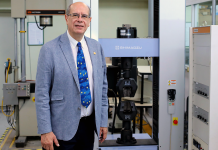Cold expansion an efficient strengthening solution
In flight, aerospace components are in a state of constant cyclic stress. The term “flying fatigue machines” is commonly used by those in the...
Inducing heat treatment for case hardening
Induction hardening has become an increasingly popular heat-treatment method for steel due to its extremely fast processing speeds. Compared to other case hardening methods,...
Metal plasticity in manufacturing
Understanding the plastic behavior of steel plays a crucial role in manufacturing. From raw billet to parts in service, some form of plastic deformation...
Gas turbine coating’s life cycle
Gas turbines on land, air, and at sea experience some extreme environments, such as high airflow, pressure, and temperature. Engines intake air from outside...
Heat treatment process modeling development for age-hardenable alloys
Age-hardenable alloys, such as some aluminum alloys, maraging steel, and nickel-based alloys, get their strength not from quenching but from the precipitation that occurs...
Heat treatment techniques overview
Editor’s note » This is the fourth in a five-part series.
In this fourth installment of my series on heat-treating techniques, I will discuss the pros...
Evaluating effect of heat treat on flank slope profile deviation of steel gears using...
The finish machining of a gear is undoubtedly one of the most important manufacturing steps. It sets the geometry, surface condition, and residual stress...
Heat treatment techniques overview
Editor’s note » This is the third in a five-part series.
In this third segment of my series on heat-treating techniques, I will discuss the pros and...
Learning from failure in bending stress
A couple of years ago, as I was finishing my graduate studies, I was lucky enough to participate in the Strong Bar competition put on...
An overview of heat treatment techniques
Editor’s note » This is the second in a five-part series.
In this second segment of my series on heat-treating techniques, I will discuss the...
Low pressure carburization simulation of steel alloys with strong carbide forming elements
Low pressure carburizing (LPC) is quickly gaining popularity across many industries due to LPC’s reduced cycle time, lack of oxidation/decarburization at and near surface,...
Stress modeling of the WAAM process
A thermal model was previously developed and executed to simulate the Wire Arc Additive Manufacturing (WAAM) process, using the Goldak Flux Distribution to model...
Linear-elastic fracture toughness testing
Materials fracture occurs in all sectors of the economy — aerospace, nuclear, medical, transportation, oil and gas, petrochemical, commercial and residential buildings, etc. The...
Gear inspection methods from heat-treat simulation
Gear design is a complex process, involving dozens of parameters, tolerances, and relationships to mating components. Generally, professional standards guide the gear designer to...
Using welding simulation tools to model WAAM
In its simplest form, additive manufacturing has been used since before the common era where low temperature melting materials such as tin, silver, copper,...
Kanthal APMT for nuclear-energy application
The major earthquake and tsunami that occurred in Japan in 2011 did serious damage to boiling water reactors of the Fukushima-Daiichi nuclear power plant....
Stress evolution during quench hardening of steel
Quench hardening of steel components involves complex, nonintuitive phenomena, particularly as it relates to the dimensional changes and stresses induced. Figure 1 shows a...
Fatigue failures in nickel-based austenitic Superalloy 718
Superalloy 718 is widely used for aerospace, nuclear, power generation, metal processing, medical, material processing, and chemical and petrochemical industries due to its excellent...
Characterizing equipment using simple modeling tools
Often, the terms “digital twins” or ICME (Integrated Computer Materials Engineering) are used when talking about computer modeling of actual parts or the behavior...
Microstructural effect of Alloy 718 on fatigue strength
Gas turbine engines are widely used in aviation, power generation, and oil and gas industries. They are used in land, air, and marine. The...
Heat transfer: Convection’s reach
Many years ago, as a mechanical engineering undergraduate student, an analogy was offered to help explain the interplay between convection and conduction in heat...
Press quenching tooling design using simulation
Steel powertrain gears are commonly carburized and quench hardened to improve strength and wear characteristics. However, solid-state phase changes occurring within the steel during...
Important to consider carbide formation during simulation
Low pressure carburizing (LPC) processes are a popular choice in industry due to LPC’s reduced cycle time, lack of oxidation/decarburization at and near surface,...
Why is modeling the immersion process so important?
Liquid quenching of long steel components can introduce significant distortion if the component is not lowered into the liquid quench bath properly. Whether the...
Improving temperature uniformity during tempering
The final step in any steel heat-treatment quenching process which produces a martensitic microstructure is tempering. Martensite is a metastable phase and is extremely...
Predicting strains key to evaluating heat-treat response
Quench hardening of steel components requires the components to be heated to a temperature such that the solid-state crystal structure of the material changes...
Accounting for carbon rejection can head off trouble
The heat treatment of steel alloys is required in almost every industry to acquire the necessary properties for a material given a particular application....
Evaluating a material’s response during austenitization
Carbon content in steel has a direct correlation to the hardness and overall strength of a component after heat treatment. Carbon can take many...
Modeling can improve press quenching process
A combination of carburization and quench hardening is often used to increase the strength and improve fatigue performance of steel parts. During quenching, stresses...
Process comparison to improve fatigue performance
Bending fatigue and contact fatigue performance can be improved by the presence of residual compressive surface stresses . Many processes can induce these compressive...
Nonlinear distortion response during gas quenching
High-pressure gas quenching (HPGQ) is touted as a way to reduce distortion of difficult-to-quench geometries. Quench pressures and quench gas flow velocities are chosen...
Surface stress is key in rolling contact fatigue
Most bearing failures can be attributed to some form of rolling contact fatigue. Many factors influence rolling contact fatigue, but two main factors are...
Simulation tools to effectively calculate process
One common goal for a wide range of industries has been to increase power density in shaft and gear components. The steel producing industry...
Determining austenite grain size
Grain size is a critical metallurgical characteristic, significantly influencing design parameters such as strength and toughness. Austenite grain size (often referred to as prior-austenite...
Microstructural evolution, its effect on Ti6Al4V alloy
Titanium alloys are extensively used in aerospace, petrochemical, marine, and medical applications, thanks to their superior strength-to-weight ratio at elevated temperature, corrosion resistance, and...
Achieving results through cold treatment
Cold treatment is a sub-zero thermal treatment process primarily used to reduce the retained austenite content of alloy and high carbon steels. Cold treatment...
Creep deformation mechanisms in 9CrMo steel
The Generation-IV reactors in nuclear power plants are expected to address the growing energy demand by producing electricity and, at the same time, mitigating...
Combatting undesirable NMTP formations
Whether formed during a conventional quench and tempering process, carburizing, or induction hardening, non-martensitic transformation products (NMTP) are widely considered undesirable microstructural features. However,...
Enhanced properties of metal matrix nanocomposites
Application of carbon nanotube (CNT) reinforced metal matrix nanocomposite (MMNC) has been increasing rapidly since the discovery of CNT in the 1990s. These novel...
How to keep decarburization in check
The performance of heat-treated steel components is largely dependent on the condition of their surface. Wear and fatigue resistance are examples of design criteria...





























